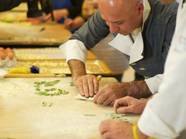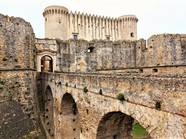Medardo Rosso, A Retrospective
The Italian Culture Month has just come to a close, after seeing many arts events staged by major centers of Italian and Italian-American culture in New York. During the month there was a strong appeal to popularize 19th century Italian art, especially among American audiences more drawn to its 20th century counterpart.
One show of particular interest is the second annual exhibit at CIMA, the Center for Italian
Modern Art, which showcased the work of Medardo Rosso (Turin, 1858 – Milan, 1928), a pioneer in the evolution of modern Italian sculpture. It is in fact difficult, according to scholars, to label this artist as belonging to any particular school. He could define the end of one breaking point and the beginning of modernity in Italian sculpture.
The opening was attended by two people extraordinarily important for understanding the artist: Danila Marsure Rosso, grandniece of the sculptor and director of the Museo Medardo Rosso of Barzio, and art historian and Rosso scholar Sharon Hecker.The show will be up at CIMA until June 2015 and explores the different artistic genres in which Medardo Rosso worked, from wax, bronze and plaster sculptures to experimental photographs—originals and prints—to abstract drawings.
The presentation helps uncover “del vero” (or realist) sculpture, which wasn’t understood well until after Rosso’s death in 1928, when it assumed greater relevance in the 20th and 21st century. Medardo Rosso was very interested in social themes and loved portraying children, the elderly and the poor in his sculptures. Hence in his studio he turned to “the real.” Rosso came to Paris for the first time in 1885, where he gained the admiration of and became friends with the French sculptor Rodin. His works become 3-D as they reflect light and cast a shadow play clearly intended by the artist.
“We wanted to examine the different kinds of materials the master worked with—photography, sculpture and drawing. As I stroll around his works, the foundation seems to take on more poetic, autonomous and discontinuous tones,” says Founder and President of CIMA Laura Mattioli. Pleased to be strolling around Medardo Rosso’s photographs, she says, “It’s really important to have had the chance to exhibit the photographs, because they are key to understanding Medardo Rosso from a contemporary viewpoint.
He is always filed away with the 19th century but we have to bring him closer to the turn of the 20th century.”Of the 115 works displayed at CIMA, fifty are original photos taken by the artist, and twenty displayed in CIMA’s kitchen are reprints depicting two different settings, the studio where he worked and the museums where his sculptures were displayed.
It’s well worth it to linger over a few stunning works like the three Madame Noblet sculptures made with different materials—one in bronze in 1897, one in plaster after 1914, and one in dark wax made between 1913-14. Rosso’s Rieuse, inspired by the enigmatic smile of Leonardo’s Mona Lisa, has never been out of Italy before now and is on loan from the Galleria Internazionale d’Arte Moderna di Ca’ Pesaro in Venice.
In the coming months there will also be a series of events with special guests, including Nicholas Cullinan, curator at the Metropolitan Museum of Art, and Isabelle Dervaux, curator at the Morgan Library & Museum.





































i-Italy
Facebook
Google+
This work may not be reproduced, in whole or in part, without prior written permission.
Questo lavoro non può essere riprodotto, in tutto o in parte, senza permesso scritto.